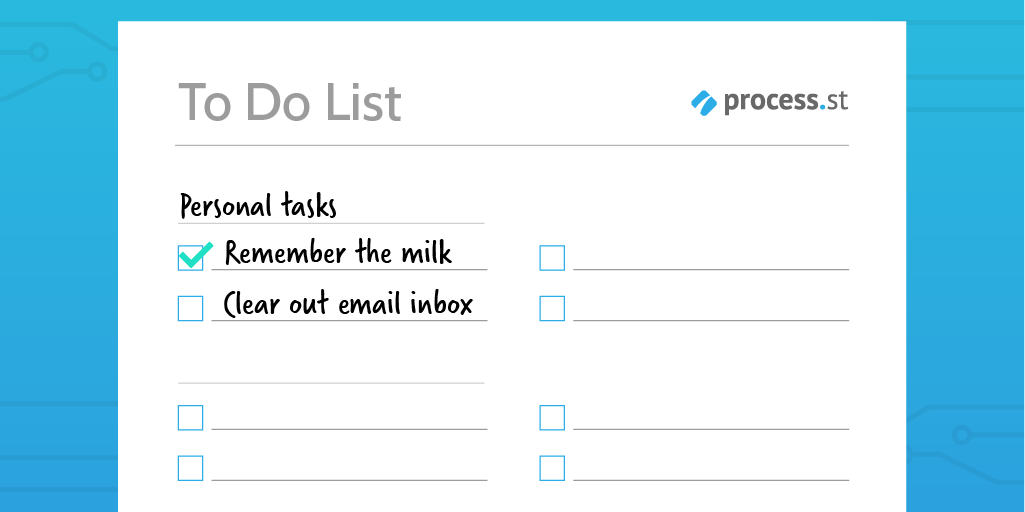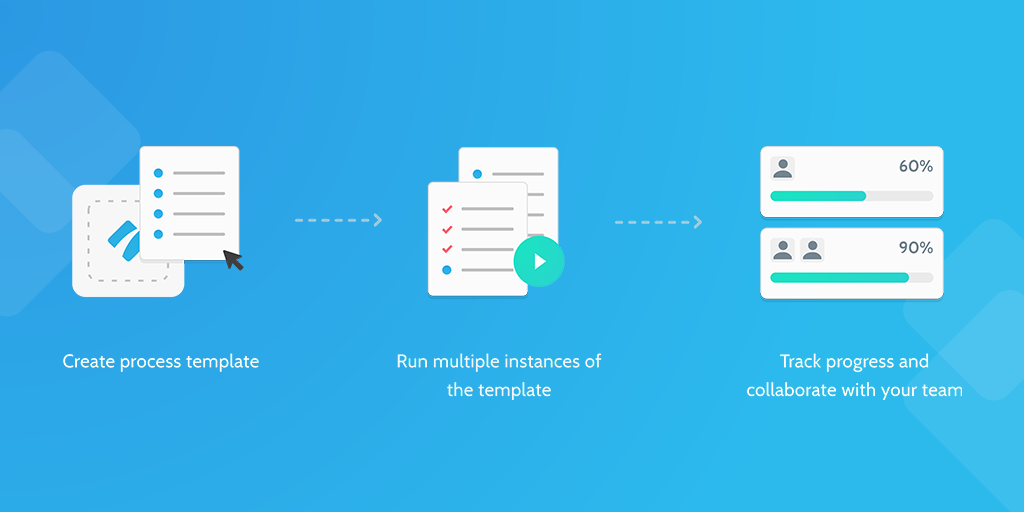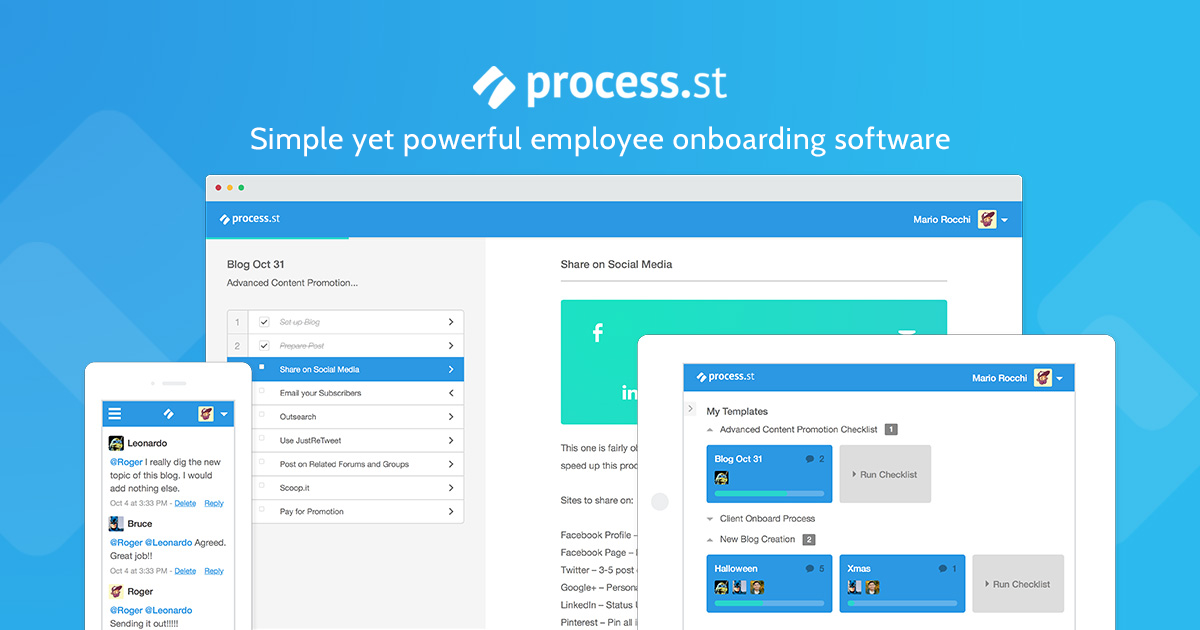
Perhaps you’ve heard about checklists. Perhaps you know someone who uses checklist templates. Who knows, you may even have a simple checklist template or two you use in your own business.
Chances are, if you clicked this link, you’re interested in learning about simple checklist templates. Or specifically, how you can use them to run your business more efficiently.
You probably already know the basics – why checklists are useful, and the value of using a BPM software like Process Street. But you want more.
You want to know the essential checklists, the ones all the top CEOs and successful executives are using. You want ready-made checklists that will save you time, money, and confusion, and you want to learn about some of the immediate benefits of using simple checklist templates, straight from the mouths of those who have used them to run successful businesses of their own.
Well, you clicked to the right article. Here, I’ll be looking at an extensive correspondence between our content team and a number of successful SMB owners who just happen to be simple checklist template champions.
Whether it’s daily, weekly, monthly, or otherwise, we’ve devised this article as a resource that will help you understand how you can use simple checklist templates in your business.
Breaking it down, we’ll look at:
- Benefits of simple checklist templates
- What simple checklist templates are successful business owners using?
- Simple checklist template essentials: Recommendations from top business owners
- How to build a simple checklist template with Process Street
But first, what is simple checklist template, anyway?
What is a simple checklist template?
A simple checklist template is any kind of process or list of tasks arranged in the form of a checklist; in other words, it’s a to-do list where the order of tasks is usually important.
This can be in written form, but more often simple checklist templates are found in the form of highly editable BPM and workflow management software tools like Process Street.
How a simple checklist template can help your business succeed
Before we dive into the deep end, let’s start off with some concise business benefits of using simple templates for repetitive daily work, or just efficiency and time-saving in general, quoted directly from some of our checklist-loving correspondents.
We’ll take a closer look at the individual use cases of each of the individuals quoted here further on in this article. For now, read about some of the direct benefits you can expect from using checklist templates in your business.
Marketing consulting agency:
“[Using checklists] allows for higher-level thinking for better problem-solving and creative innovation which positively impact our bottom line.” – Marsha Kelly, president of Best4Business
Digital marketing agency:
“Checklists help our team stay focused on what matters and provide consistent quality across campaigns.” – Nicole DeLeon, founder of North Star Inbound
National car selling service:
“As the co-founder I spend a great deal of time dealing with standard operating procedures and checklists certainly come in handy for that.” – Sean Pour, co-founder of SellMax
Wilderness review and guide website:
“As other editors know, there are a million and one tiny details that must be checked before publishing an article. Between formatting, punctuation, grammar, tone, vocabulary, etc. – the list is endless!
Having a checklist keeps me sane and guarantees that I get everything done promptly and stress-free.
Another benefit to checklists is that they keep me focused. With keyword research, it’s easy to go down the rabbit hole and waste hours trying to figure out what to do.
My checklist tells me exactly what to do and ensures I don’t waste energy doing unnecessary tasks.” – Mike Miller, editor-in-chief at Wilderness Times
AI & customer service support tool:
“Our business is growing rapidly which means it is getting more difficult to manually manage day-to-day tasks. Checklists help us maintain a high standard as we scale. We use checklists varying from how to handle and follow up with customer service emails to checklists for what to do before and after publishing a blog post.
One thing that we’ve learned is that checklists are especially useful in team settings. We’ve seen that checklists help keep coworkers accountable when it comes to collaborative projects. The increased visibility into who’s doing what really streamlines the process.
We use checklists as a helpful way to maintain high-quality work.” – Dylan Max, head of growth marketing at Netomi.
Career & education guide:
“I use checklists to manage my daily tasks and make sure nothing is left undone. I’m trying to promote this with my employees: every employee has a list to follow with the essential dates and to-dos.” – Darko Jacimovic founder of What to Become
SEO/Marketing:
“Before I had a concrete checklist built out, I would be working on today’s and tomorrow’s pressing issues, only to find out there was a major venture I needed to be working on for Friday.
Granted, I am someone who is prone to getting stuck in the day-to-day weeds, simply having a concrete checklist for the upcoming two weeks really improved my productivity, and performance.” – Tim Brown, owner of Hook Agency
Interior design & furnishings:
“This also means that we are able to maintain control of all of our customer service touchpoints, where consistent messaging and the terms and conditions of our sale and discounts are clearly displayed for a streamlined customer experience.” – Nathan Thompson from iakoe
Project management consulting:
“Checklists facilitate a DYJ (do your job) style of management. There might be dozens of pieces to the puzzle spread across an entire project team, but when each task is assigned to an individual owner, the pieces of the puzzle can come together quickly.
Just so long as everyone worries about the deliverable assigned to them, the big-picture initiative gets done.
These lists can be based on industry standards, eg: GMP or GLP (Good Manufacturing/Laboratory Practice). These provide an outline that can be customized to the organization and the tasks at hand.
Ideally, this provides a clear path for a top-down strategy (organizational vision → business case → project plan → standards → action item list) with a clear path directly back up for execution.
So long as everyone ticks their item off the checklist, the project plan is fulfilled, which realizes the intended benefits, and the organization gets closer to its vision.” – Gus Cicala CEO and owner of Project Assistants
And more! Read on for the checklists top executives are using every day to run their business.
What simple checklist templates do business owners use?
 We asked a range of SMB owners and executives about the simple checklist templates they use on a daily basis. Here’s a rundown, in no particular order, of each of these simple checklist template use cases.
We asked a range of SMB owners and executives about the simple checklist templates they use on a daily basis. Here’s a rundown, in no particular order, of each of these simple checklist template use cases.
I’ve grouped this section based on the niche of each business, for clarity.
How a marketing consulting firm uses simple checklist templates
Some of the checklist templates Marsha Kelly’s Best4Business marketing consulting firm uses on a daily basis include:
- Daily reports and metrics review: To ensure all systems are working and moving toward goals.
- Content creation checklists: Multiple processes for topic research, article structure, writing quality, and a set of steps for publishing and promoting onsite content.
- Work receipt checklists: This is essential for quality management, to check all outsourced and third-party vendor deliverables. This list has job specifications and quality measures. It is vital to use immediately upon delivery to ensure acceptability or to request revisions if work does not pass the checklist process.
How a dietary supplement company uses simple checklist templates
Calloway Cook is president of dietary supplement retailer Illuminate Labs. He uses two checklists for running his business.
“The first is an overall checklist of business goals. I am constantly updating this list, and order it by the timeline that goals need to be completed. The short-term goals are placed immediately after the completed tasks, while longer-term goals are farther down the list.
This strategy helps me organize my workday.
The second business checklist I use is a list of purchases/spending that needs to occur. The items are ranked in terms of priority. A software tool that would increase efficiency but isn’t immediately necessary would be further down the list, while an inventory purchase that needs to be completed within the month would be closer to the top.
Using this spending list helps me organize and plan expenses for my business.”
How a wilderness gear and guide website uses simple checklist templates

Mike Miller is the editor-in-chief at Wilderness Times, whose mission statement is “to provide you with the tools and information you need to fully enjoy your time outdoors.”
He also uses Process Street to streamline his checklists and tighten up his processes for editing and keyword research as much as possible.
“I have two major checklists I use (religiously).
The first is for editing articles. When you manage multiple writers for your site, it’s crucial that you quality-check every article to make sure it’s up to your standards.
The second is for keyword research. When I have an idea for an article, I go through a complete five-step process to make sure that this keyword is a solid choice from an SEO perspective.
If I miss one step, I might waste my time publishing a bad article. Process Street helps make sure that I knock out every item on my list.”
How a digital marketing agency uses simple checklist templates
Nicole DeLeon is the founder of North Star Inbound, a digital marketing agency focusing on SEO, PR, and link building.
According to Nicole, the agency uses checklists for various internal and client-facing tasks.
“We use an onboarding checklist to ensure new hires are ready to hit the ground running on day one.
Also, we use checklists for building out promotion outreach lists to ensure quality and no missed opportunities. In our fast-paced environment, it’s easy to forget essential details.”
How a financial consultant uses simple checklist templates
Rob Stephens, founder of CFO Perspective told us about his two most important sets of checklists. He uses simple checklist templates for:
- Production processes
- Data backups
“My most important checklists are for production processes. Over time, I’ve learned the most efficient and effective order of my production process. There are steps that are easy to forget that I capture in the checklist. The checklist strikes the perfect balance between full documentation of a process and relying on my memory.
Production checklists also prepare the process for outsourcing. I can outline steps that can be grouped together and performed by another employee or contractor. The checklist informs the employee or contractor how their tasks fit into the larger process. If they notice something is missing in the product when it gets to them, they can look at the checklist to see if an earlier step was missed or if the missing piece will be completed in a later step.
Software programs automate the backup process for most of my data. However, some information is so valuable that I manually backup the files to a location other than where the automated backups are stored. System failures don’t worry me when I have critical information backed up via two different processes and in two different locations.”
How a personal financier uses simple checklist templates
RJ Bryan is a full-time entrepreneur with over 7 years of experience in the personal financing space. He runs CreditReps as a co-founder.
“We use multiple checklists for all aspects and processes in our business
(and those checklists have checklists)”
Some of the checklists RJ uses include:
- Customer validation checklist
- Weekly and monthly report checklists
- New business checklist (Metrics that qualify a new income stream to add to the current business model)
- Onboarding checklist
- Blog content pre-publishing checklist
- On-page SEO checklist
- Keyword research/traffic checklist
- Ad content pre-publishing checklist
How a domain name search engine uses simple checklist templates

Axel DeAngelis, founder of domain name search engine NameBounce told us about some of the simple checklist templates he uses daily.
He has two main tips to offer. Here’s the first:
“Each day, I use a time tracking checklist, SEO task checklist, and a website development checklist.
By breaking down a large goal into a series of tasks, I find that it’s easier to complete each task and communicate with other people on a project.”
His second tip:
“I created a checklist that I use as a lead magnet for people using my website. It’s a 41-point business launch checklist that contains an interactive status box, links to resources that help readers complete each task, and comments containing our recommendations.”
How an online job portal uses simple checklist templates
Martin Luenendonk is a data-driven business innovator, top business growth expert, and the co-founder & CEO of Cleverism, an online job portal packed with unique jobs in just about every field.
“Our business does not rely on a single checklist. We have narrowed down the list to the processes, not the departments. It helps us to identify the error in minimal time and fix it. We work in a co-working space, so there is no need to develop a checklist for finance, office expenses, and other bills. Yes, we also use checklists for our services.
We provide content marketing services to customers and use three main checklists for this purpose.”
Here are some of Martin’s checklists:
- Client’s requirements – For keeping track of the client’s needs among the services offered.
- Do-Read – For employees, demonstrating how to do a task.
- Do-Confirm – For employees and supervisors, the final check before delivering work.
How a career and education guide uses simple checklist templates
Darko Jacimovic from What To Become elaborates on how checklists help him save time and stay organized:
“As a business owner, I have a pretty hectic schedule, and my productivity
depends on my time-management skills.I like to give feedback frequently, and we have a clear schedule about when reports should be sent, when we’re meeting, what should be done in that period, etc.
Other checklists include office management related issues, and they make sure we never run out of supplies.”
How a real estate firm uses simple checklist templates
Matthew Yu is president of Socotra Capital, a nationwide real estate lending and investment firm based in Sacramento, California.
“Checklists are integral to our lending business. I would like to think that we use them a little bit TOO much. But that’s ok, more is better than less, better to err on the side of caution when it comes to our work.
Every business will have its own checklist. Ours started with breaking down our processes step by step. The first checklist we use is a CRM. Salesforce provides lead management and reminders to call them, which is in essence a checklist. That checklist produces quality conversations that we end up converting into an actual deal. Once they arrive in our deal funnel, we have a checklist for ‘items needed’, which helps maintain the accuracy and integrity of our loan files for underwriting.
Once that checklist is complete, we go through an underwriting checklist. We even have a grocery checklist for our kitchen! Checklists are great ways to declutter and remove the stress and anxiety of having a bulk of tasks.
Human minds are not built to remember EVERYTHING, that is why lists and tech reminders are so important to everything we do. If it can help you reduce clutter and stress, make a checklist!”
How a HR tech company uses simple checklist templates
Siddhartha Gupta is CEO of Mettl, a HR technology company and leading talent measurement firm that enables businesses to make precise people decisions in the areas of talent recruitment, management and training across industry verticals.
“For product design, creation, and new version releases we use a lot of workflows to ensure our products cater to the needs of the audience.”
Market research
“For any product design, it’s critical to research on the ground level. Our teams talk to a lot of stakeholders, understand the competitor’s product proposition and features, and try to understand how our product can offer the same and some additional features to the audience.
It’s utterly difficult to break through the clutter and chaos of various brands vying for the customer’s attention. One has to talk to a lot of new and existing customers and understand their pain points to create any product.”
Product design
“Then, comes the implementation of market research into product design.
Products are run through pilots internally and on a small set of population, various feedback from multiple people are sought, and multiple iterations are made to the product.”
Customer feedback
“After selling various products to the market, it’s time to understand how best products were able to meet their expectations in resolving their challenges.
Customer success teams talk to customers for their feedback and issues with the products.”
New version release
“After thoroughly understanding what shortcomings our products had and how the customers think they could be improved, we work on all those issues to bring better and new features to our products.
These changes again go through the cycle of pilot runs after which it’s launched into the market as the latest releases of the products.”
Simple checklist template essentials: Recommendations from top business owners
 We asked these same business owners about their recommendations for simple checklist templates, as well as any they consider to be absolutely essential to running their SMBs.
We asked these same business owners about their recommendations for simple checklist templates, as well as any they consider to be absolutely essential to running their SMBs.
This section is also grouped by niche.
Simple checklist template essentials for a sleep and mattress review website
We spoke to co-owner and COO Matthew Ross from MySlumberYard, one of the leading sleep and mattress brands, who runs a review website and a successful YouTube channel.
The company employs 12 individuals and is on track to exceed $5 million in yearly revenue.
Matthew believes it’s crucial that small businesses use onboarding checklists to hire and train new employees. He goes on to say:
“I think it is crucial small businesses have an onboarding checklist for newly hired employees. As a small company, you simply don’t have the resources that large corporations possess so organization and efficiency become even more important.”
He recommends using these simple checklist templates for running a SMB:
- Administrative onboarding paperwork (employee handbook, release forms, W-4, I-9, etc.)
- New employee onboarding (for time tracking, company chat platforms, email, workflow software, etc.)
- General employee onboarding
“This will ensure new employees are able to hit the ground running and immediately start contributing to the company.”
If you’re interested in a free, ready-to-go employee onboarding checklist, check this one out:
Simple checklist template essentials for a wilderness gear and guide website
We asked Mike over at Wilderness Times what simple checklists he thought every business should be using.
“As a Process Street user myself (thanks AppSumo!) I’m excited to share my experience with you.
I recommend other businesses take a look at their most crucial and most repeated tasks and make checklists for them. Often, the most important tasks are the ones you do the most, so it should be easy to decide what you want to make a checklist for.
Ask yourself, what two or three activities are the lifeblood of my business?
From there, start by writing down everything you need to do for this job. Then, organize the steps and add detailed instructions.”
If you’re something of an adventurer yourself, you may appreciate this simple camping checklist:
Simple checklist template essentials for nationwide car buying service
Sean Pour, the 25 years old co-founder of SellMax, a nationwide car buying service let us know about his essential daily checklists.
“The daily task list is a must-have. It’s been such a big part of my success, I couldn’t work without it.”
Sean also recommends the “new ideas checklist”.
“I feel the new idea checklist makes sure we are staying on top of the ever-changing landscape. So, it assures that we are constantly innovating.
In addition, the ‘daily task’ list serves to motivate myself and the company. It’s easy to feel like you’re not making progress when you are working towards a huge goal.
But, you can look back at the checklist and realize you’ve done a lot.”
Here’s one of our very own daily to-do-list templates:
Simple checklist template essentials for personal financiers
RJ Bryan, co-founder of Credit Reps told us about his highest checklist recommendations for businesses with a blog, or any kind of content creation process.
“Every business that has a site and/or blog should have a Blog Content Checklist and On-page SEO checklist.
These two checklists work together to construct the best content for your business.
Not to mention, it helps teach new employees or freelancers how to execute the task at hand.”
And more broadly:
“My essential checklist is the classic to-do checklist. Every night, or EOD, I check my list to confirm that I’ve gotten everything done. If not, it goes on the list for tomorrow.
If everything is done, I just look for tasks that will move the needle and make my list for the next day.
This is important: I keep my daily to-do list short. I only add 3 tasks that will move the needle once they’re complete. I recommend 3-5 tasks.
Keeping your list short helps to avoid having the neverending to-do list with unproductive items like ‘check email’.”
Click here to get our on-page SEO checklist:
Simple checklist template essentials for a company time-off planning service
Phil Norton, founder of company time-off planner Leave Dates had some advice for streamlining one of the most common HR processes.
“Before taking time off, employees should run through a checklist of items to ensure the have handed over their work, they have set an out of office, they have blocked out their calendar and rearranged meetings and they’ve caught up with their manager.
Taking time to plan your leave and making arrangements for your cover will help ensure you take your full allowance, and ensure that you aren’t worried about (or, more importantly, doing) work on vacation.”
If you’re looking for a ready-to-go holiday leave application checklist, you can sign up to a free Process Street trial and use our prebuilt one below!
Simple checklist template essentials for a domain name search engine
More tips from NameBounce’s Axel DeAngelis, this time regarding essentials and recommended checklists.
“It’s important to create a separate checklist for each new client. In the checklist, it’s important to follow a standard process, and make sure that you aren’t missing any essential onboarding or follow-up tasks.”
The importance of time-keeping is also highlighted:
“I use a time tracking checklist on a daily basis. In the spreadsheet, I track my weekly goals, daily goals, the time I spent on each task, and the total time I spent working each day.
This forces me to stay accountable with my productivity, and helps me see the big picture of what I am working on.”
Here’s our client onboarding checklist for a managed service provider:
Simple checklist template essentials for a graphic design agency
David Irwin, Owner and CEO of the eponymous David Irwin Design uses checklists daily in his routine as a graphic design agency.
“I actually have two simple checklists and I think they are both important in different ways.
The first is a simple morning routine checklist. This sets me up for the day and allows me to conduct my design business in the most efficient way possible.”
Here’s an outline of David’s morning routine checklist:
- Collect mail & sort through it first thing.
- Check email (Not respond but highlight important emails to respond to later in the morning.
- Follow up with freelance staff messages(Check overnight deliverables or dailies) this is specific to design work as it will indicate what I need to follow up on.
- Reach out to clients first thing & let them know I am available & in the office. Especially important if I have a deliverable that day. I try to do this via a quick phone call check-in.
- Respond to emails & let freelancers/employees know I will get back to them with changes within the hour.
“That’s it, generally the first part of my day is then planned for at least 2 hours.
My second checklist has to do with business continuity, which is especially important when working with a distributed team as it will mean I may not control the office.”
Here’s a breakdown of David’s second process for ensuring business continuity, adapted from our correspondence:
- Ensure servers are backed up every week to a cloud-based server (sync worked, files from individual employees are saved correctly.
- Located and designate a second office site, especially for local teams (this could be a cafe or public library).
- Ensure there is a templated email with current contact details for everyone on the team to be sent to the client should a BC incident happen.
- Setup & run a test roll call for employees or a call tree. In case of emergency, employee wellbeing and accountability is paramount. Even besides the business, their personal knowledge & experience is number 1 priority, which makes safety a priority.
- Ensure & test the above plan from a remote location, to ensure servers, files, shared programs and devices are accessible from a remote location at least once a year.
“Ensuring the safety and security of employees should be paramount, which is why the call tree is implemented. That means designated individuals will contact each other and check back in with me.”
Simple checklist template essentials for an online job portal
Cleverism’s Martin Luenendonk has some recommendations for how to best serve clients using a simple checklist template.
“The client’s requirement checklist is a must. It would become next to impossible to deliver the right end product without this. Every requirement must be separated beforehand to state the cost rightly and to provide quality work within time.”
On checklist essentials:
“There are two essential checklists because it helps us to measure our performance every month. One is ‘client’s requirement’, and the other one is ‘client’s satisfaction’.”
We use the first one when we start working with the client and the second one after delivering the work and its acceptance. It assists us in recognizing which areas we should improve.”
How to build simple checklist templates with Process Street
 You’ve heard about how great checklists can be, now how about putting pedal to the metal and trying it out for yourself? One of the best ways to get started is with a BPM software like Process Street.
You’ve heard about how great checklists can be, now how about putting pedal to the metal and trying it out for yourself? One of the best ways to get started is with a BPM software like Process Street.
So how does Process Street work? Think superpowered checklists.
Any checklist starts by breaking down a process into its most important tasks. In Process Street, you can quickly and easily edit templates using the rich form fields and features available in our web and mobile app.
Once you build your first checklist template, you can launch an infinite number of checklists from the master template, and keep track of them all using the Template Overview feature!
Whether you’re a distributed remote team or a good old-fashioned brick and mortar firm, you can use Process Street to ensure your checklists are of the highest quality, and that they’re always serving you exactly you how need them to be.
This webinar is a great introduction to getting started with Process Street for business and workflow management and automation:
By now you surely understand checklists, but… superpowered checklists? Why superpowered?
When you use Process Street for your checklists, you can take advantage of:
- Conditional logic to control complex and branching processes
- Stop tasks to enforce what order certain tasks are completed – to make sure important work doesn’t get missed, or processes bottlenecked by out-of-sync work.
- Task assignments to streamline new work and tasks to individual members, or even whole groups!
- Role assignments for even more flexibility when assigning tasks dynamically, meaning new employees and clients are integrated seamlessly.
- Task permissions for hiding crucial or sensitive information on a need-to-know basis.
- Approvals for effortlessly approving or rejecting work, directly from your email inbox.
Hopefully this article helped you on your way to business process mastery by providing real-world context and insight into how simple checklist templates are used by top business owners. If you have more stories about how you use checklists in your business, let us know in the comments!







Oliver Peterson
Oliver Peterson is a content writer for Process Street with an interest in systems and processes, attempting to use them as tools for taking apart problems and gaining insight into building robust, lasting solutions.